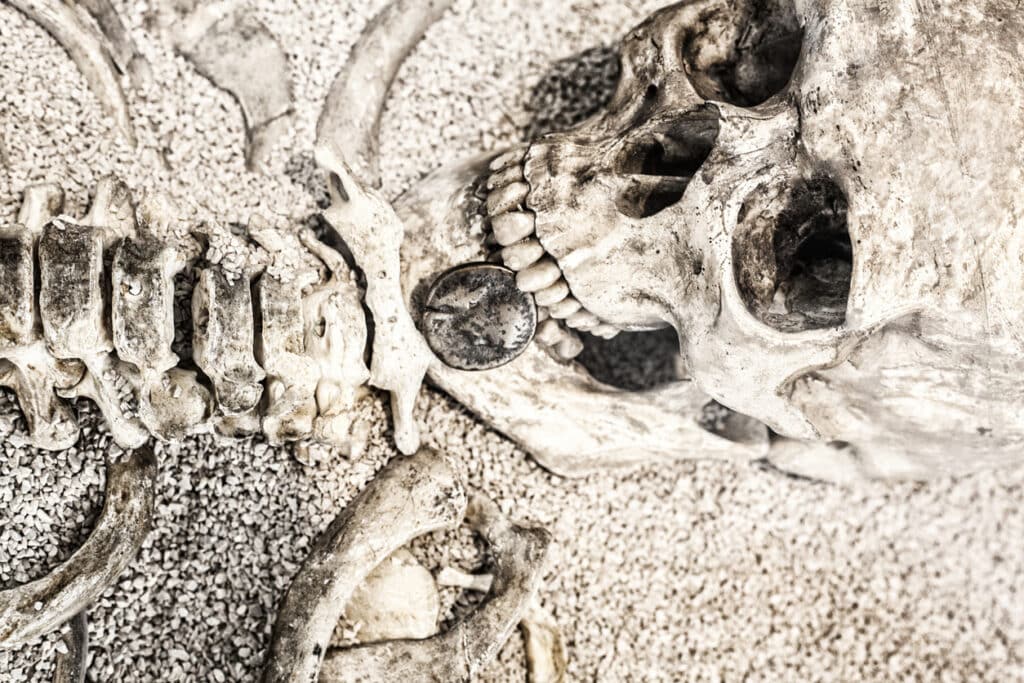We set aside several days and times during the year for honoring family and friends who have died. Memorial Day honors military members who have died, and in October and November we celebrate Halloween, Hallowtide, or Day of the Dead to remember those who have passed on before us. Coins have frequently played an important part in funeral rituals. Throughout history, many cultures have had practices that involve coins for the dead, often referred to by archeologists as Charon’s Obol.
What Is Charon’s Obol?
Numerous ancient cultures had practices of leaving coins or wealth for (or with) their dead loved ones for various purposes. Egyptian pharaohs were buried with their riches so they would have everything they might possibly need in the afterlife.
The ancient Greeks believed that the dead needed to pay the boatman Charon to ferry them across the River Styx into Hades, the underworld. If they could not pay, they would have to wait on the banks of the river for 100 years instead. A coin called Charon’s Obol was placed in the person’s mouth or with the body at burial for the voyage and as a seal to protect the person’s soul and keep it from returning.
While the obolos was a basic denomination of Greek coinage, worth one-sixth of a drachma, the term “Charon’s obol” was used to mean grave goods for the journey into the afterlife. Other small-denomination local coins made from metals varying from gold to silver, bronze or copper, were also used. In some cases they weren’t even coins, per se. Tokens, wooden coins, or gold-foil crosses were all used to pay Charon’s boat fare.
The Romans adopted this burial practice as well and the custom spread throughout the Roman empire from Gaul to Hispania to Britain and even into Germania and Israel. In literature of these times, Charon’s obol was widely understood to refer to a single coin of little worth that was placed in the mouth of the deceased person at the time of their death, representing a boat fare. Archeologists have found coins and remains of coins in skulls, graves, and crematory urns in burials from the 5th century B.C. onwards, appearing with the advent of minted coinage.
Coins for Dead Servicemen
If you go to a military cemetery, you may see coins left on the gravestones. This is both an American and a Canadian tradition and is meant to show respect for the deceased’s sacrifice. The coins left behind signify how close a relationship the visitor had with the deceased and if they served together. In this context a penny on a gravestone means that a person visited, a nickel signifies that the person was in boot camp with the deceased veteran. If the visitor served alongside the deceased, it’s traditional to leave a dime, and a quarter means that the visitor was there when the veteran was killed in service.
During the Vietnam War, because of disagreements about politics and the appropriateness of the war, this practice became a common way of showing a person had visited, rather than contacting the deceased veteran’s family directly.
These coins are often collected by the cemetery and used for grave maintenance, care for indigent soldiers, or soldiers’ burial costs. Some larger cemeteries prefer visitors not leave coins as they can fall in the grass and cause injuries to workers when the lawns are mowed.
Coins preserve human history. People use them in their everyday lives for many purposes, and they tuck them away with their beloved dead as a sign of grief or memory or to help preserve them in the afterlife. If you are interested in collecting ancient coins or contemporary coins of any sort, call us at Grand Rapids Coins. We would be happy to discuss your needs, evaluate your collection, or find that rare coin you’ve been searching for.

